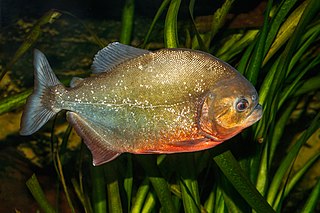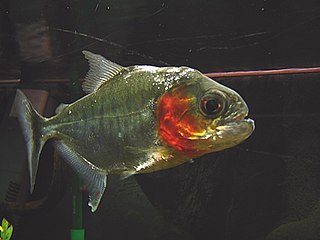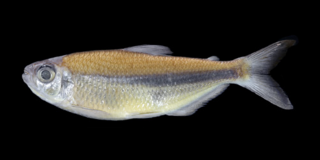
A piranha or piraña is any of a number of freshwater fish species in the family Serrasalmidae, or the subfamily Serrasalminae within the tetra family, Characidae in order Characiformes. These fish inhabit South American rivers, floodplains, lakes and reservoirs. Although often described as extremely predatory and mainly feeding on fish, their dietary habits vary extensively, and they will also take plant material, leading to their classification as omnivorous.

Pygocentrus is a genus of the piranha family Serrasalmidae. All species are native to tropical and subtropical South America. All the species are predatory, scavengers and may form large schools. The famous red-bellied piranha, Pygocentrus nattereri, is one of four species in the genus.

Pseudoplatystoma is a genus of several South American catfish species of family Pimelodidae. The species are known by a number of different common names. They typically inhabit major rivers where they prefer the main channels and tend to stay at maximum depth, but some species can also be seen in lakes, flooded forests, and other freshwater habitats. They have robust bodies, and are important food fish. Recently, their population size has been on the drastic decline due to a variety of factors including overfishing and habitat destruction due to the construction of hydroelectric dams.

The Serrasalmidae (serrasalmids) are a family of characiform fishes, recently elevated to family status. It includes more than 90 species. The name means "serrated salmon family", which refers to the serrated keel running along the belly of these fish. Fish classified as Serrasalmidae are also known by these common names: pacu, piranha, and silver dollar. These common names generally designate differing dental characteristics and feeding habits.

The red-bellied piranha, also known as the red piranha, is a type of piranha native to South America, found in the Amazon, Paraguay, Paraná and Essequibo basins, as well as coastal rivers of northeastern Brazil. This fish is locally abundant in its freshwater habitat. They are omnivorous foragers and feed on insects, worms, crustaceans, and fish. They are not a migratory species but do travel to seek out conditions conducive to breeding and spawning during periods of increased rainfall. Red-bellied piranhas often travel in shoals as a predatory defense but rarely exhibit group hunting behavior. Acoustic communication is common and is sometimes exhibited along with aggressive behaviors. They are a popular aquarium fish.

Pristobrycon is a genus of piranhas from the Orinoco and Amazon Basins, as well as rivers in the Guianas.

Bryconops is a genus of freshwater fish in the family Iguanodectidae from South America. It consists of small fish, all under half-a-foot long, with slender bodies and silvery scales, though there is some mild color variation. Several species can be identified by way of a humeral patch, and others have a reddish ocellus, or eyespot, on one or both lobes of the dorsal fin.
Pristobrycon careospinus is a species of serrasalmid endemic of Venezuela.

Pristobrycon calmoni is a South American species of serrasalmid fish.
Pristobrycon striolatus is a species of serrasalmid fish.

Synodontis batesii is a species of upside-down catfish native to rivers of Cameroon, the Democratic Republic of the Congo, Equatorial Guinea and Gabon. It was first collected by G. L. Bates and described by Belgian-British zoologist George Albert Boulenger in 1907, based upon holotypes discovered in the Dja River, near Bitye in Cameroon. The specific name "batesii" refers to the name of the collector of the first specimen.

Synodontis schoutedeni, known as the yellow marbled Synodontis, is a species of upside-down catfish native to the Congo Basin of the Democratic Republic of the Congo and the Republic of the Congo. It was first described by Belgian ichthyologist Lore Rose David in 1936, based upon a holotype discovered in Basongo, in what is now the Democratic Republic of the Congo. The specific name "schoutedeni" is named after the Belgian zoologist Henri Schouteden.
Pygocentrus palometa is a species of piranha native to South America, where restricted to the Orinoco Basin. Although recognized by FishBase, the scientific name may be a nomen dubium.
Bryconops colanegra is a small, slender-bodied species of freshwater fish from South America, about 3.5 in long. It has a black tail fin that bears hints of red, and its scales are dark along the back, transitioning to a silver belly. It is native to a single river system in Venezuela, the Rio Caroní.

Bryconops colaroja is a small species of fish from the fresh waters of South America. The specific epithet "colaroja" means "red tailed", and it gets this name from its most distinctive feature - a deep red caudal fin, largely unique amongst members of its genus. It lives in tributaries and creeks that are a part of the Cuyuni river basin.
Bryconops humeralis is a small freshwater fish distributed across northern South America. The name "humeralis" means "relating to the shoulder", in reference to the distinct humeral patches that the fish sports. It is slightly longer than average in terms of the genus Bryconops, though still firmly within the standard range, and is slightly more slender than is usual for its congeners.
Bryconops inpai is a small freshwater fish native to the rivers of South America. It only lives in two particular river systems - the Casiquiare and Negro - which means that its range is restricted to the northern half of the continent. It has indistinct humeral spots, and is bluish-silver in life, which is unusual for members of Bryconops; they are more often plain silver or greenish-silver.

Bryconops tocantinensis is a small freshwater fish from the rivers of Brazil. It has yellow-gold scales on its back and white scales on its belly, with a bright-silver stripe marking the divide between the two. It gets the name "tocantinensis" from its endemism to the upper Tocantins basin drainage - specifically, the Conceição River.
Bryconops vibex is a small freshwater fish from the rivers of Venezuela, known solely from the Rio Cataniapo. The body is slender, though with an element of sturdiness, and it has one humeral spot by each pectoral fin. It bears visual similarities to several congeners, but can be differentiated by way of many factors.
Bryconops allisoni is a species of freshwater fish known from the rivers of Brazil. It is a recent addition to the genus (2019), currently considered a member incertae sedis. Its name honors Antonio Machado-Allison, an ichthyologist responsible for a great deal of work on the genus Bryconops.









